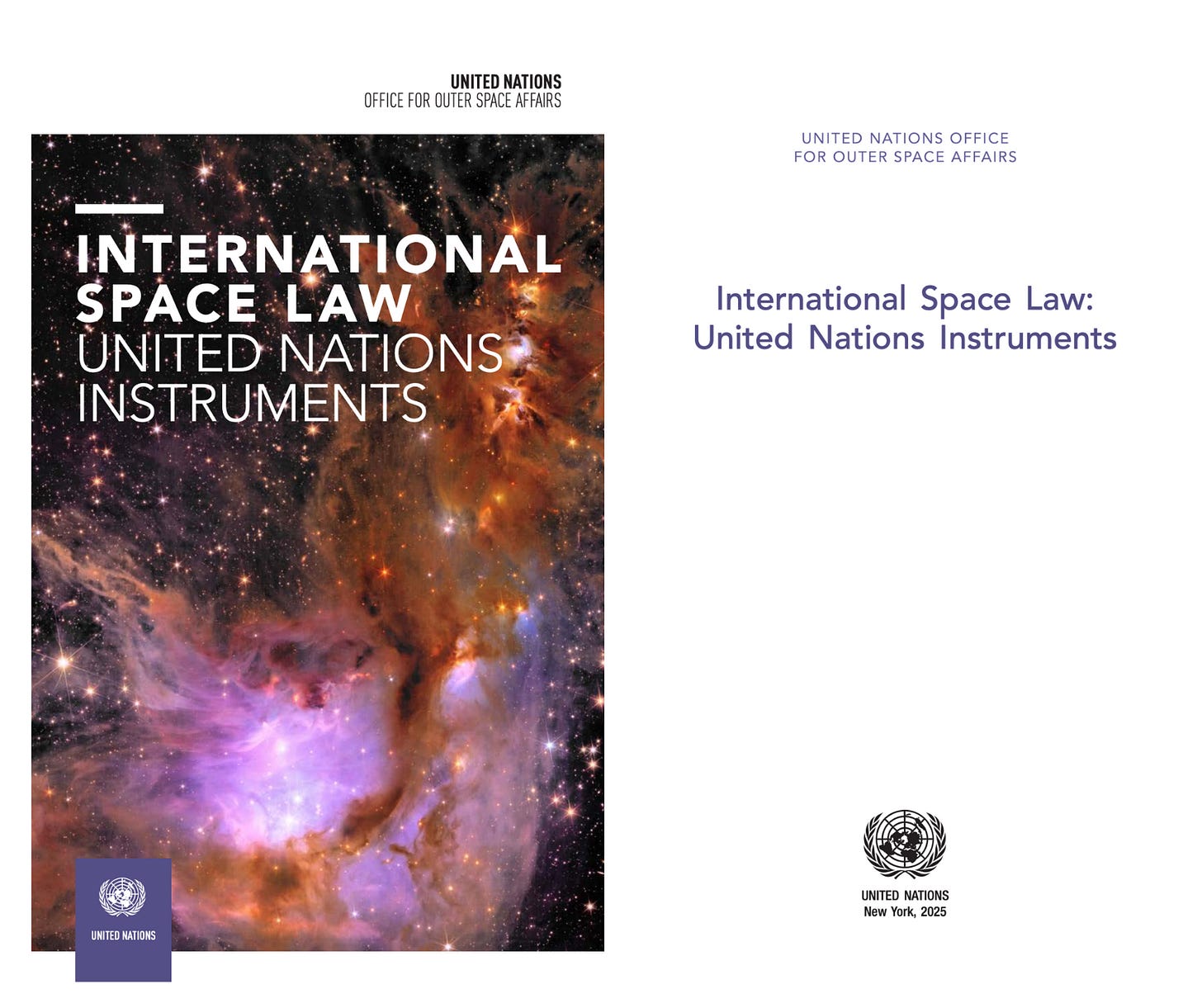Legal Update: Space Law Since 1967 With Aspirations Written, But Accountability Missing
UNOOSA has updated its treaty booklet, consolidating core space law treaties and sustainability guidelines, ensuring accessible international legal framework for space activities.
International space law has become an uneven patchwork of commitments, voluntary guidelines, and contested interpretations, and yet the newly released United Nations treaty booklet presents it as a comprehensive and reliable framework. Such presentation conceals persistent gaps in compliance, the limits of enforcement, and the reality that non-binding guidelines are increasingly treated with the authority of binding treaties.
UNOOSA Updates Treaty Booklet: International Space Law Instruments for Today and Tomorrow
The United Nations Office for Outer Space Affairs (UNOOSA) has released the latest edition of its treaty booklet International Space Law: United Nations Instruments (New York, 2025).
This updated volume brings together the cornerstone treaties, principles, and related resolutions that govern activities in outer space.
It also incorporates the Guidelines for the Long-term Sustainability of Outer Space Activities adopted by the Committee on the Peaceful Uses of Outer Space.
The publication continues a tradition of more than two decades of producing accessible and authoritative resources for practitioners, policymakers, academics, and industry actors who navigate the expanding frontier of outer space activities.
The booklet provides an essential consolidation of the legal instruments that form the backbone of international space law.
It is both a collection of treaties and a reflection of the collective effort of States within the United Nations to provide predictability, transparency, and cooperation in an increasingly complex domain.
Its release in 2025 is indeed a moment in which outer space activities have grown far beyond the capacities of early spacefaring nations and have become a shared area of interest for developed and developing States alike.
International Law for a Shared Domain
The Director of UNOOSA, Aarti Holla-Maini, introduced the updated booklet by describing it as the most comprehensive and up-to-date compilation of instruments under the auspices of the United Nations.
These instruments continue to form the principal body of international space law, designed to provide a reliable framework for peaceful exploration and use of outer space.
The booklet reminds us that the year 1967 marked a milestone in space history with the entry into force of the Outer Space Treaty, which remains the foundational legal instrument in this field.
Since then, the United Nations has facilitated a series of treaties, principles, and resolutions that together articulate responsibilities, rights, and expectations for States.
The new edition integrates the Guidelines for the Long-term Sustainability of Outer Space Activities, presenting them as a contemporary counterpart to the traditional treaty framework.
Part One: United Nations Treaties
The booklet opens with the five core treaties of international space law:
The Outer Space Treaty (1967). This treaty sets the foundation for all space activities, affirming that exploration and use of outer space shall be carried out for the benefit of all countries and that space is free for exploration without discrimination. It prohibits the placement of nuclear weapons in orbit or on celestial bodies and establishes outer space as the province of all humankind.
The Rescue Agreement (1968). This treaty elaborates on the obligations of States to assist astronauts in distress and to ensure the safe return of both astronauts and space objects.
The Liability Convention (1972). This treaty addresses responsibility and liability for damage caused by space objects, ensuring that States remain accountable for the consequences of activities carried out under their jurisdiction.
The Registration Convention (1976). This treaty obliges States to register space objects launched into outer space, reinforcing transparency and accountability.
The Moon Agreement (1979). This treaty extends the principles of the Outer Space Treaty to the Moon and other celestial bodies, focusing on cooperative exploration and equitable benefit sharing.
Together, these treaties continue to form the backbone of international space law.
The updated booklet provides full texts, depositary information, and context for each treaty, making it a comprehensive reference for both new and experienced practitioners.
Part Two: General Assembly Principles
Beyond treaties, the United Nations has adopted principles that reflect international consensus on specific areas of space activity.
These include the Declaration of Legal Principles Governing the Activities of States in the Exploration and Use of Outer Space, principles on remote sensing, principles relevant to the use of nuclear power sources in outer space, and a declaration on international cooperation in exploration and use of outer space for the benefit of all States.
While not legally binding, these principles provide interpretive guidance and reinforce the cooperative ethos underlying international space law.
Part Three: Related Resolutions
The booklet also compiles key General Assembly resolutions that have supported the legal regime, including the foundational resolution 1721 (XVI) B of 1961, which established the practice of registering space objects, and resolution 68/74 of 2013, which provided recommendations on national legislation relevant to peaceful exploration and use of outer space.
These resolutions have played a critical role in supporting consistent national implementation and promoting wider participation in space governance.
Part Four: Other Documents
This section of the booklet contains important guidelines and frameworks that complement the treaty regime.
Among them are the Space Debris Mitigation Guidelines, the Safety Framework for Nuclear Power Source Applications in Outer Space, and most recently, the Guidelines for the Long-term Sustainability of Outer Space Activities.
The Guidelines on sustainability, adopted in 2019, are voluntary but carry strong political and practical weight.
They are designed to support States and international organizations in ensuring that outer space remains accessible, safe, and usable for current and future generations.
They stress that outer space is a finite resource that requires careful management to avoid risks associated with debris, interference, and overcrowding.
The Guidelines for Long-term Sustainability of Outer Space Activities
The inclusion of these guidelines in the 2025 treaty booklet signals their importance as a reference point for national regulators and international cooperation.
The guidelines define long-term sustainability as the ability to maintain space activities indefinitely in a way that ensures equitable access to the benefits of exploration and use for peaceful purposes.
They emphasize a number of areas, including:
The adoption and revision of national regulatory frameworks to reflect international obligations.
The need for States to supervise both governmental and non-governmental activities in accordance with Article VI of the Outer Space Treaty.
International cooperation, capacity-building, and sharing of information through the Committee on the Peaceful Uses of Outer Space.
Measures to ensure equitable and efficient use of the radio-frequency spectrum and orbital slots.
Promotion of scientific research and development of sustainable technologies.
Consideration of new methods to manage the long-term challenge of space debris.
By consolidating these guidelines within the treaty booklet, UNOOSA has ensured that they are no longer treated as an annex to discussions but as an integral component of the international legal framework.
Technical and operational measures
On the technical side, the guidelines include detailed expectations for the design, operation, and disposal of space objects.
They recommend that satellites be designed for trackability and that operators consider methods that facilitate accurate orbital determination.
They also encourage measures to address risks associated with uncontrolled re-entry, including designing systems for controlled disposal.
Debris management is a recurring theme.
The guidelines call for States and international organizations to investigate and adopt new measures to manage debris, such as collision avoidance, spacecraft passivation, and design improvements that support disintegration during re-entry.
These measures are not meant to impose undue costs, particularly on emerging space actors, but rather to promote a fair and inclusive system of sustainability.
The guidelines also address space weather, calling for the development of standards to mitigate adverse effects on satellites, training to improve knowledge transfer, and the design of spacecraft that can withstand or recover from harmful space weather events.
Conclusion: A Foundation for Future Action
UNOOSA’s updated treaty booklet arrives at a time when outer space activities are expanding in scale and scope.
The booklet consolidates the foundational treaties that have guided the peaceful use of outer space since 1967 and integrates contemporary guidelines that address modern challenges such as debris, congestion, and equitable access.
It shows that international space law is not static but continues to develop through treaties, resolutions, and guidelines that reflect shared commitments.
The booklet is a tool for engagement with the future of space activities.
Whether working on satellite communications, liability frameworks, insurance, or national legislation, the booklet equips professionals with the core instruments for this complex field.
The UNOOSA treaty booklet is therefore not only a record of past commitments, but also a platform for future cooperation.
It provides States and organizations with the resources needed to ensure that outer space remains open, safe, and accessible for the benefit of all humankind.
As outer space law continues to expand through treaties, resolutions, and guidelines, your perspective is essential.
Share your thoughts on how these developments affect technology, business, and governance. Reply with comments, and let us advance this discussion together.






So much has happened in this space. I have bookmarked and hope to follow its developments.